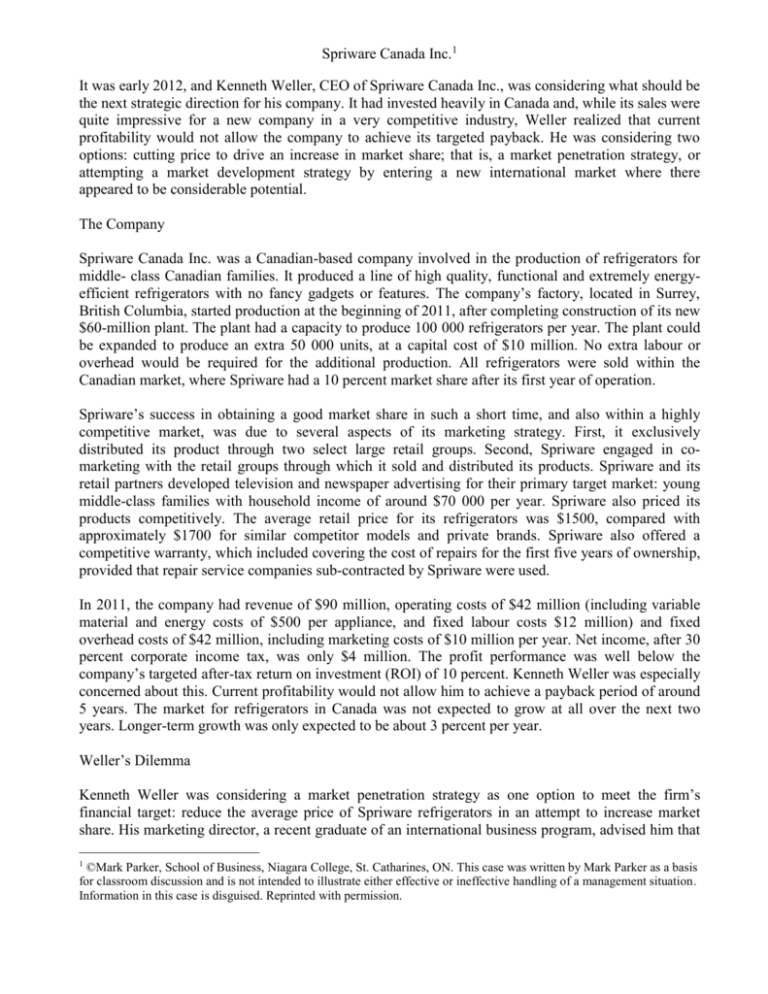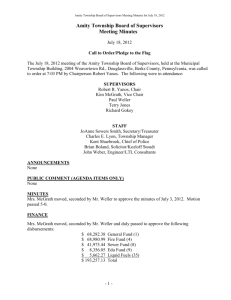sss - Homework Market
advertisement

Spriware Canada Inc.1 It was early 2012, and Kenneth Weller, CEO of Spriware Canada Inc., was considering what should be the next strategic direction for his company. It had invested heavily in Canada and, while its sales were quite impressive for a new company in a very competitive industry, Weller realized that current profitability would not allow the company to achieve its targeted payback. He was considering two options: cutting price to drive an increase in market share; that is, a market penetration strategy, or attempting a market development strategy by entering a new international market where there appeared to be considerable potential. The Company Spriware Canada Inc. was a Canadian-based company involved in the production of refrigerators for middle- class Canadian families. It produced a line of high quality, functional and extremely energyefficient refrigerators with no fancy gadgets or features. The company’s factory, located in Surrey, British Columbia, started production at the beginning of 2011, after completing construction of its new $60-million plant. The plant had a capacity to produce 100 000 refrigerators per year. The plant could be expanded to produce an extra 50 000 units, at a capital cost of $10 million. No extra labour or overhead would be required for the additional production. All refrigerators were sold within the Canadian market, where Spriware had a 10 percent market share after its first year of operation. Spriware’s success in obtaining a good market share in such a short time, and also within a highly competitive market, was due to several aspects of its marketing strategy. First, it exclusively distributed its product through two select large retail groups. Second, Spriware engaged in comarketing with the retail groups through which it sold and distributed its products. Spriware and its retail partners developed television and newspaper advertising for their primary target market: young middle-class families with household income of around $70 000 per year. Spriware also priced its products competitively. The average retail price for its refrigerators was $1500, compared with approximately $1700 for similar competitor models and private brands. Spriware also offered a competitive warranty, which included covering the cost of repairs for the first five years of ownership, provided that repair service companies sub-contracted by Spriware were used. In 2011, the company had revenue of $90 million, operating costs of $42 million (including variable material and energy costs of $500 per appliance, and fixed labour costs $12 million) and fixed overhead costs of $42 million, including marketing costs of $10 million per year. Net income, after 30 percent corporate income tax, was only $4 million. The profit performance was well below the company’s targeted after-tax return on investment (ROI) of 10 percent. Kenneth Weller was especially concerned about this. Current profitability would not allow him to achieve a payback period of around 5 years. The market for refrigerators in Canada was not expected to grow at all over the next two years. Longer-term growth was only expected to be about 3 percent per year. Weller’s Dilemma Kenneth Weller was considering a market penetration strategy as one option to meet the firm’s financial target: reduce the average price of Spriware refrigerators in an attempt to increase market share. His marketing director, a recent graduate of an international business program, advised him that 1 ©Mark Parker, School of Business, Niagara College, St. Catharines, ON. This case was written by Mark Parker as a basis for classroom discussion and is not intended to illustrate either effective or ineffective handling of a management situation. Information in this case is disguised. Reprinted with permission. based on her analysis, the firm could increase market share to 15 percent if he reduced his prices by 10 percent. This would enable Spriware to take market share away from lower quality brands, by effectively offering its product at the same price, but with better performance and warranties. In the longer term, the manager believed that with proper marketing and product positioning strategies, Spriware could obtain 20 to 25 percent of the Canadian market, as Canadian households were increasingly looking for greater value for their money. While this was an option, Weller’s concern was that his pricing today was already competitive for the products Spriware offered, and reflected fair value for what customers received. Why should Spriware under-sell itself? As well, any price reduction strategy he feared could start an aggressive price war in the short term. This was, after all, an industry with 10 manufacturers, all of whom had excess capacity and were aggressive in maintaining sales volumes. A second option Weller was considering was to export to an overseas market in an attempt to produce and sell more refrigerators. His highly skilled marketing director, through intelligence gathering, had identified market potential in the island nation of Mabuhailand, located in the Pacific region around Indonesia and the Philippines. Mabuhailand in the last 20 years had emerged into a fairly stable democracy, governed by the pro-business centrist Liberal Democratic Party. This follows nearly 30 years of corrupt dictatorship and infighting among various extreme political factions, several of whom still exist and are reported to be dissatisfied with the distribution of political power formed under the country’s new constitution. Extreme groups were considered to be either ultra-nationalistic and antiforeigner, or left wing with a desire for complete control of the nation’s emerging commercial and industrial system. Some of the groups were reported to have links to the Chinese government, whose past political and economic involvement in the country is still resented by many of its people. Despite its success, the country has been plagued at times with some violent protests, resulting in blockades of roads and disruption of some commercial activities. The people are an interesting mixture of Chinese, Malay, and Portuguese, the result of past colonization when Portugal had occupied areas such as Formosa, which today is Taiwan. The dialect, known as Latgalog, is unique to the country. Little is known about it, especially the symbolic aspects of the language. It is described as Brazilian Portuguese with an Asian sound to it. Literacy rates, while improved, are still quite low. Only about 70 percent of the population is literate. However, virtually all young people under the age of 18 (25 percent of the population) are receiving education; they show a great interest and are highly motivated to learn. English is compulsory in school as of age five. Mabuhailand has one government-owned television station, though only about 30 percent of households own a television. One privately held national newspaper, Mabu Express, is in circulation in the country. The culture is one characterized by strong family ties, with two or more generations living within the same household. A strong sense of obligation to the community exists, and community social activities are focused around the local churches, which are either Catholic or non-traditional Protestant. Informal communication within communities is an important source of information for many people. Traditional authority is shown great respect. However, many younger families are now looking to live on their own following the country’s growing economic prosperity. Mabuhailand is rich in natural resources, including high value precious metals, copper, cobalt, diamonds, and off-shore oil reserves. Following political change, the country’s leaders encouraged foreign investment in order to develop these resources and train the population. The ruling party’s policy has been to ensure that domestic industries are encouraged through a competitive and stable tax policy. Resources account for 40 percent of the economy, and the government is looking to encourage more value-added manufacturing as part of the economic mix. An industrious and hard working people of around 10 million, they have increased the country’s GDP in ten years from $40 billion to $120 billion in 2011. Over the next five years it is forecast that economic development policies will grow the economy by $10 billion each year. Most tax revenues, which represent 30 percent of GDP, are derived from business taxes and import duties, and have enabled the country to build needed infrastructure, including ports, roads, electric power utilities, and social services, such as hospitals and schools. But more will be needed. Economists at the International Monetary Fund predict that over the next five years, government spending could rise to at least $50 billion annually, based on the government’s infrastructure and social spending plans. Up until now, the government has resisted borrowing to finance spending, and as a matter of policy strives to achieve balanced budgets. Total outstanding government debt is estimated at 40 percent of GDP. Because many of the nation’s 2.5 million households now have power, and given the country’s growing per capita income levels, Weller believes there is great opportunity for refrigerator sales in this country. A benchmarking exercise with other developing nations suggests that based on Mabuhailand’s per capita income levels, annual purchases should be one refrigerator for approximately every forty households. At the moment, the purchase of refrigerators in 2011 was only 20 000 units, according to government import statistics. There is no local production of refrigerators. The retail value of these imports was estimated at $24 million. Weller suspected there may be several reasons for this low level of demand. First, import statistics showed that virtually all the units were reexports from Hong Kong, which Weller suspected were secondary, low quality units likely made in China. Second, the sale of refrigerators was handled by numerous small scale retailers, many of whom were not appliance specialists. These retailers were remnants of the old traditional economy, but new larger and modern retailers have begun to emerge. These refrigerators tended to be purchased from numerous traders, who purchased these appliances from various manufacturers in China, and re-sold them to any outfit that would take them. There was no advertising or marketing of any significance. Weller was confident that there was a tremendous opportunity in Mabuhailand both now and in the future, and believed that he could successfully create a first mover advantage and quickly become the market leader. Weller believed that at the projected rate of economic growth, the resulting gains in income would result in one in thirty households purchasing refrigerators within the next five years, and one in twenty households would purchase refrigerators within 10 years. Spriware’s market studies further suggested that, based on the performance of neighbouring markets, Spriware could sell refrigerators into Mabuhailand at $1400 per unit, net of distribution costs. The price would not include import duties paid to the government, which would represent 5% of the selling price. This duty was applied to all of the nation’s $40 billion of annual imports. Although Kenneth Weller was excited about the trade opportunity, he knew he had to give it some thought. There were many issues to consider. First, there was the risk that the Mabuhailand economy might not grow as strongly as was forecast? Around two-thirds of the resource sector’s growth was due to a doubling in prices over the past 10 years rather than due to an increase in output. The nation’s economic forecast was based on a doubling of resource production in the next 5 years and stable prices at current levels. This reflects strong demand in emerging nations such as China and India. Yet many observers believe that fundamentally the prices of the nation’s commodities should have only increased 3 to 5 percent per year in the last decade, rather than having doubled. As a result, there is a concern that the prices of these commodities run the risk of collapse. Second, Kenneth Weller knew that to be positioned in this market longer term, he would eventually have to build a plant in the country, even if it was smaller scale than the Canadian operation. Weller had discussions with senior Ministry of Industry and Trade representatives, who visited him in Surrey to discuss this trade opportunity. The sense he got from the discussions was that the government would likely accept imported products for a period of time, but eventually its policy would be to encourage domestic industries. No doubt, Weller thought, the government would soon use duties as a policy to encourage and protect domestic development of the industry. Still the longer-term opportunity in Mabuhailand was great, and there could be additional opportunities in neighbouring countries. Government officials hinted of possible moves of neighbouring countries to develop a regional trading bloc, with the goal of eliminating import duties and excess customs regulations. But, Weller wondered, did he want to commit assets in Mabuhailand? Labour costs would be 20% of what it is in Canada, but what about productivity and training needs? What about marketing and promotion? Kenneth Weller felt it was time to have a discussion with his management team and obtain their input as to what would be the best course of action for the company. Questions 1) Has Spriware successfully marketed its products in Canada? Explain why or why not? 2) In your opinion, should Spriware enter the market of Mabuhailand? 3) Assuming the company decided to enter Mabuhailand, what should its market entry strategy be? Fully justify your answer.








